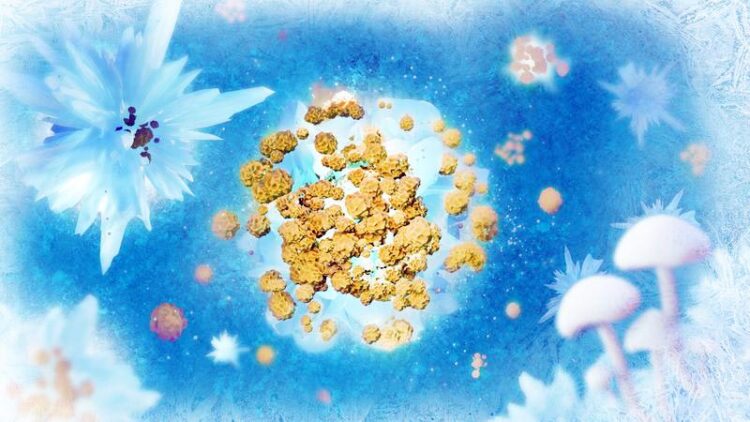Small proteins, big effect

Proteins from fungi are efficient condensation nuclei: they support the formation of ice. The exact molecular mechanisms have now been investigated by a team led by Konrad Meister.
© MPI-P
How fungal proteins efficiently make ice.
Snow and hail are formed in clouds, while fungi and other microorganisms thrive on the ground. But the fact that the two can be related, with microbes influencing ice formation in clouds, has been studied in more detail only in recent years. Researchers at the Max Planck Institute for Polymer Research led by Konrad Meister have now investigated in more detail how microbes achieve ice formation at the molecular level and how it can be exploited technologically.
Water freezes at zero degrees Celsius – that’s what we learn in school. However, pure water without impurities only freezes at much lower temperatures around -40 degrees Celsius. Only so-called condensation nuclei – such as dust or dirt particles – cause higher freezing temperatures. Certain biological substances found in pollen, bacteria or even fungi are particularly efficient in supporting such ice formation. However, the molecular basis and precise mechanisms of such “biological ice nuclei” were poorly understood until now.
“We looked at a fungus of the genus Fusarium that is particularly efficient at driving ice formation,” said Konrad Meister, a professor at Boise State University (USA) and group leader at the Max Planck Institute for Polymer Research in Mainz in Mischa Bonn’s department. The fungus is a well-known plant pathogen worldwide. Spores can, for example, rise up into the atmosphere, where they boost ice formation with special ice-nucleating substances.
The international research team led by Meister has now been able to show what exactly enables ice formation and how the ice-making substances are structured. They were able to show that small proteins are involved, which can aggregate outside the fungus to form larger protein aggregates. Thanks to their size, these aggregates enable very efficient ice-making. This could be confirmed by Meister and colleagues experimentally and not least also with theoretical calculations of American colleagues around Prof. Valeria Molinero of the University of Utah.
According to Meister, the mechanism of forming larger aggregates from smaller building blocks is found not only in fungi but also in other organisms. “Nevertheless, we were surprised by the small size of the fungal protein building blocks compared to their efficiency,” Meister points out. “Other known and similarly efficient ice-making proteins from other organisms, for example, are 25 times larger.”
An even more detailed understanding of the molecular mechanisms could help to produce such efficient proteins artificially as well. Applications would include energy-efficient freezing of food, artificial generation of snow, or biological cloud seeding.
The researchers have published their results in the journal “Proceedings of the National Academy of Sciences (PNAS)”.
Wissenschaftliche Ansprechpartner:
Prof. Dr. Konrad Meister
meisterk@mpip-mainz.mpg.de
Originalpublikation:
Ralph Schwidetzky, Ingrid de Almeida Ribeiro, Nadine Bothen, Anna T. Backes, Arthur L. DeVries, Mischa Bonn, Janine Fröhlich-Nowoisky, Valeria Molinero and Konrad Meister:
Functional aggregation of cell-free proteins enables fungal ice nucleation;
Proceedings of the National Academy of Sciences, 120, 46 (2023)
https://dx.doi.org/10.1073/pnas.2303243120
Small proteins, big effect | Max Planck Institute for Polymer Research (mpg.de)
Media Contact
All latest news from the category: Life Sciences and Chemistry
Articles and reports from the Life Sciences and chemistry area deal with applied and basic research into modern biology, chemistry and human medicine.
Valuable information can be found on a range of life sciences fields including bacteriology, biochemistry, bionics, bioinformatics, biophysics, biotechnology, genetics, geobotany, human biology, marine biology, microbiology, molecular biology, cellular biology, zoology, bioinorganic chemistry, microchemistry and environmental chemistry.
Newest articles

Innovative 3D printed scaffolds offer new hope for bone healing
Researchers at the Institute for Bioengineering of Catalonia have developed novel 3D printed PLA-CaP scaffolds that promote blood vessel formation, ensuring better healing and regeneration of bone tissue. Bone is…

The surprising role of gut infection in Alzheimer’s disease
ASU- and Banner Alzheimer’s Institute-led study implicates link between a common virus and the disease, which travels from the gut to the brain and may be a target for antiviral…

Molecular gardening: New enzymes discovered for protein modification pruning
How deubiquitinases USP53 and USP54 cleave long polyubiquitin chains and how the former is linked to liver disease in children. Deubiquitinases (DUBs) are enzymes used by cells to trim protein…



